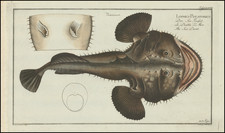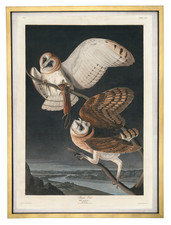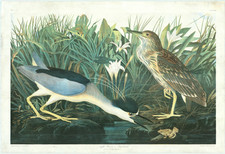"[This] plate was a comedy of errors." - Susanne M. Low
A handsome example of John James Audubon's double-elephant folio first edition aquatint of the Magnolia Warbler on a Swamp Chestnut Oak - though you would not know for reading the legend on the plate!
The Magnolia Warbler (Setophaga magnolia) is a small, colorful songbird found in North America. It is known for its distinctive black streaks on a bright yellow underside, with a white belly and undertail coverts. The male Magnolia Warbler has a black mask across its eyes and a yellow crown, while the female has a less prominent mask. These warblers are migratory birds, spending their summers in the northern United States and Canada and wintering in Central America and the Caribbean. They are often spotted in mixed woodlands and shrubby habitats during their breeding season, where they forage for insects and spiders.
Here, a young male is shown perched on the branch of a Swamp Chestnut Oak (although the legend calls it a White Oak). The Swamp Chestnut Oak (Quercus michauxii) is a sizable deciduous tree native to the southeastern United States, characterized by its impressive stature, large glossy leaves, and distinctive acorns with fringed caps. Often found in wetland areas like swamps and floodplains, this oak species thrives in wetter soils, providing valuable habitat and a food source for wildlife. Its wood is prized for its durability and finds use in furniture, flooring, and cabinetry. While not endangered, the conservation of Swamp Chestnut Oak habitats is essential for preserving biodiversity and ensuring the well-being of various animal species that rely on it.
Low's Commentary
Painting and plate depict one immature bird in a branch of Swamp Chestnut Oak. A very faint pencil inscription on the painting may say: "Louisiana. Oct. 20, 1821." The whole situation regarding the painting and plate was a comedy of errors. Audubon wrote that he drew this immature bird, which he called Black and Yellow Warbler, for inclusion with the two Magnolias in Plate CXXIII, but Havell misunderstood and made a separate plate of it. Then Audubon wrote "Swainson's Warbler" on the painting, which was a mistake evidently made in haste. He did paint the Swainson's, which is in CXCVIII. Audubon wrote of the confusion regarding this painting and plate in Ornithological Biography.
State
Low's second of two plate legend variants.
John James Audubon's Double Elephant Folio Birds of America: The Havell Edition (1827-1838)
The present hand-colored original Audubon print comes from the Havell double elephant folio edition of Birds of America, the greatest color plate book ever made. This work was Audubon's magnum opus and was published at immense expense over almost a decade, between 1827 and 1838. The Havell Edition of Birds of America included 435 hand-color aquatinted plates, and it is estimated that between 165 and 175 complete sets were produced. Today, a given individual image probably exists in no more than 60 loose examples, though for some plates the number will be much lower. Audubon aquatint engravings from the Havell Edition were printed on J. Whatman wove paper, the best paper in the world at the time - and to this day an exceptional fine art paper. The sheets of paper were approximately 26½ x 39½ inches untrimmed. Importantly, they all feature watermarks that are variations on "J.Whatman" or "J.Whatman / Turkey Mill" with the date of manufacture sometimes appended. In addition to the name of the bird depicted (and sometimes its gender, age, and botanical notes as well) Audubon's name and the name of the engraver also appear printed on Havell Edition plates. On the lower left side is printed "Drawn from nature by John James Audubon F.R.S. and F.L.S." (Fellow of the Royal Society of London and Fellow of the Linnaean Society). The only exception to this is Plate 64, Swamp Sparrow, in which Lucy Audubon is credited. On the lower right side is printed "Engraved by" (in a few cases the words "Engraved and colored by" or "Retouched by" appear) followed by the name W.H. Lizars or Robert Havell, Jr. (Sometime after his father's death in 1832 Robert Havell, Jr. dropped the Jr.)
Robert Havell Jr. was the principal engraver of Audubon's Birds of America, perhaps the most significant natural history publication of all time.
Havell's aquatint engraving of all but the first ten plates of John James Audubon's Birds of America is now recognized as a significant artistic achievement in its own right and an essential component of the success of Birds of America. He and Audubon became close friends and associates during their lengthy collaboration.
In 1839, Havell went to America at the invitation of Audubon, first residing in Brooklyn. He settled in Ossining on the Hudson River and later moved to Tarrytown, New York, living there from 1857 through his remaining years. Although Havell continued to work in aquatint and engraving (primarily city panoramas), he devoted most of his attention to painting the countryside of the Hudson River valley. He travelled frequently in a homemade horse-drawn trailer, sketching and taking notes and translating his sketches into larger oils.
Robert Havell Jr. is considered a member of the Hudson River School of American painters.
John James Audubon (1785-1851), born Jean-Jacques Rabin in Haiti on April 26, 1785, was a Franco-American ornithologist, naturalist, and painter, celebrated for his detailed illustrations of North American birds in their natural habitats. His major work, a color-plate book titled The Birds of America, is considered one of the finest ornithological works ever produced.
Audubon's early years were shaped by tumultuous events. Born out of wedlock in the French Caribbean colony of Saint-Domingue (now Haiti) to a Creole mother and a French sea captain, he was smuggled to Nantes, France, during a slave rebellion. There, he was adopted by his father and stepmother and raised as their own. His childhood in France was filled with outdoor adventures and initial forays into drawing.
In 1803, to avoid conscription into Napoleon's army, he was sent to America, where he managed one of his father's estates near Philadelphia. This move further kindled his profound interest in the wildlife of the New World. Despite a few failed business ventures and challenges, Audubon remained committed to his passion for nature and art.
His dream to document all of the birds of America began to take form in the 1810s. Travelling through America's wilderness, Audubon observed, hunted, and painted birds. He developed a particular technique that involved wiring freshly killed birds into a natural pose on a board. This innovative method combined with his keen observation allowed him to create more lifelike illustrations than many of his contemporaries.
Failing to secure American subscribers or a publisher for his extensive collection, Audubon traveled to the United Kingdom in 1826. There, The Birds of America was met with critical acclaim. Between 1827 and 1838, this work was published in sections, comprising 435 hand-colored, life-sized prints made from engraved plates.
Audubon followed this success with a companion work, Ornithological Biography, which provided detailed narratives about each species. His later work included studies of American mammals, and he became one of the founding members of the New-York Historical Society.
Despite facing numerous challenges throughout his life, including financial hardships and criticism from some peers, Audubon's dedication to his work resulted in an invaluable contribution to ornithology and American art. He died on January 27, 1851, in New York City. Today, his legacy continues, notably through the National Audubon Society, which promotes conservation and appreciation of birds and their habitats.











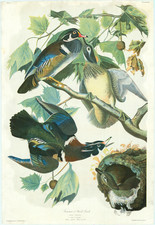
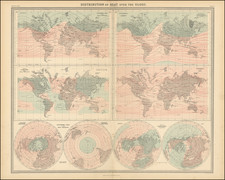
![[ Astronomer William Herschel ] Wm. Herschel](https://storage.googleapis.com/raremaps/img/small/99581.jpg)
